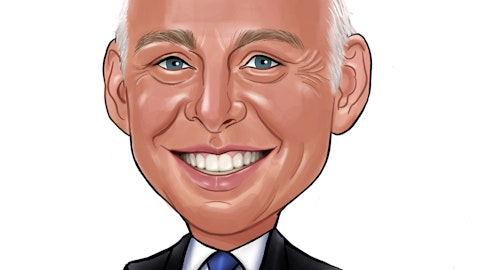Univest Financial Corporation (NASDAQ:UVSP) Q4 2023 Earnings Call Transcript January 25, 2024
Univest Financial Corporation isn’t one of the 30 most popular stocks among hedge funds at the end of the third quarter (see the details here).
Operator: Good morning, everyone, and welcome. My name is Drew, and I’ll be your operator today. At this time, I would like to welcome everyone to the Univest Financial Corporation Fourth Quarter 2023 Earnings Call. [Operator Instructions] I will now turn the call over to your host, Jeff Schweitzer, President and CEO of Univest Financial Corporation. Please go ahead.
Jeffrey Schweitzer: Thank you, Drew, and good morning. And thank you to all of our listeners for joining us. Joining me on the call this morning is Mike Keim, our Chief Operating Officer and President of Univest Bank and Trust; and Brian Richardson, our Chief Financial Officer. Before we begin, I would like to remind everyone of the forward-looking statements disclaimer. Please be advised that during the course of this conference call, management may make forward-looking statements that express management’s intentions, beliefs, or expectations within the meaning of the federal securities laws. Univest’s actual results may differ materially from those contemplated by these forward-looking statements. I will refer you to the forward-looking cautionary statements in our earnings release and in our SEC filings.
Hopefully, everyone had a chance to review our earnings release from yesterday. If not, it can be found on our website at univest.net under the Investor Relations tab. We reported net income of $16.3 million during the fourth quarter or $0.55 per share. During the quarter, we started to see stabilization in the shift in the mix of deposits along with the cost of deposits. While loans declined slightly during the quarter due to the higher rate environment, the payoff of some potential problem credits and a general slowdown in economic activity, we continue to have solid pipelines as we enter 2024. We continue to focus on full relationship customers and prospects. Brian will provide additional guidance for 2024 in his comments. Before I pass it over to Brian, I’d just like to thank the entire Univest family for the great work that they do every day and their continued efforts serving our customers, our communities, and each other.
I’ll now turn it over to Brian for further discussion on our results.

Brian Richardson: Thank you, Jeff, and I would also like to thank everyone for joining us today. I would like to start by touching on six items from the earnings release. First, during the quarter, we saw signs of NIM stabilization. Reported NIM of 2.84% declined 12 basis points from 2.96% in the third quarter. This compares to an 18 basis point decline during the third quarter. Additionally, core NIM which excludes excess liquidity of 2.94% declined 6 basis points compared to the third quarter. This compares to a 14 basis point decline during the last quarter. Second, as it relates to our loan and deposit activity, loans contracted by $7.7 million during the quarter and grew $444 million or 7.3% during 2023. Deposits contracted by $63.4 million in the quarter and grew by $462.3 million, or 7.8% during 2023.
The $63.4 million decrease in the fourth quarter included a $57.5 million reduction in brokered CDs. During the fourth quarter, we saw signs of stabilization as it relates to non-interest-bearing deposits, which increased by $35.8 million compared to a decrease of $150 million last quarter. As of December 31st, non-interest-bearing deposits represented 23% of total deposits, compared to 22.2% at September 30th. Third, during the quarter, we recorded a provision for credit losses of $1.9 million. Our coverage ratio was 1.3% at December 31st, compared to 1.28% at September 30th. Net charge-offs for the quarter totaled $1.1 million or 6 basis points annualized. Fourth, non-interest income decreased $1.8 million, or 9% compared to the fourth quarter of 2022.
This was primarily driven by decreases in wealth management revenue, BOLI income and swap-related fees. These decreases were driven by a $1.2 million adjustment for previously unrecorded wealth management revenue and 526,000 of BOLI death benefits, both of which were recognized during the fourth quarter of 2022. Interest rate swap income also decreased $1.5 million, compared to the fourth quarter of 2022. Fifth, non-interest expense increased $1.7 million, or 3.6% compared to the fourth quarter of 2022. This includes 642,000 of incremental FDIC expense, which is primarily driven by the industry-wide increased assessment rate. Lastly, during the fourth quarter, we repurchased 26,485 shares of stock and plan to opportunistically repurchase shares in 2024.
I believe the remainder of the earnings release was straightforward and I would now like to focus on five items as it relates to 2024 guidance. First, for 2023, net interest income totaled $220 million. For 2024, we expect loan growth of approximately 4% to 5% and we expect net interest income to be flat to down 3%. This assumes a stable rate environment and NIM bottoming out in the first half of the year and inclining thereafter as we see – start to see stability on the liability side coupled with continued repricing of assets. Second, the provision for credit losses will continue to be driven by changes in economic forecasts and the credit performance of the portfolio. At this time, we expect the provision for 2024 to be approximately $11 million to $13 million.
Third, 2023 non-interest income totaled $26.8 million. For 2024, we expect non-interest income growth of approximately 4% to 6% off the $76.8 million base. Fourth, we reported non-interest expense of $197.4 million for 2023. For 2024, we expect growth of approximately 3% to 5%. Lastly, as it relates to income taxes, we expect our effective tax rate to be approximately 20% to 20.5%, based on current statutory rates. That concludes my prepared remarks. We will be happy to answer any questions. Drew, would you please begin the question-and-answer session?
See also 15 Highest Quality Butter Brands in the US and 15 Highest Quality Multivitamin Brands of 2024.
Q&A Session
Follow Univest Financial Corp (NASDAQ:UVSP)
Follow Univest Financial Corp (NASDAQ:UVSP)
Operator: [Operator Instructions] Our first question today comes from Tim Switzer from KBW. Please go ahead.
Tim Switzer: Hi, guys. Good morning. Thanks for taking my questions.
Brian Richardson: Good morning, Tim.
Jeffrey Schweitzer: Good morning, Tim.
Tim Switzer: Thank you for the guidance. Appreciate it. I think the first question I have is your NII guide, assuming stable rates, could you talk about maybe what the impact of a rate cut or two would be, if we get some in the back half of the year? So after the NIM has bottomed, assuming maybe deposit competition has moderated a little bit, what’s the impact you expect from just a couple of rate cuts? And then does that impact change if we get deeper into the cut cycle, say, into like 2025, and the Fed has cut, say, 4 times to 5 times or more?
Brian Richardson: Okay. This is Brian. I’ll take that one. So a little bit of it, I mean, rate environment and forward rates has certainly got an impact on things, but it’s really customer expectations and customer behavior, coupled with that really of competition on the liability side. So that said, we would really expect the first couple on based on kind of forward expectations right now on Fed actions and the like, we have seen some abatement on deposit cost pressures. I do think the first couple will have an impact, but be relatively minimal because we do have variable rate loans that will automatically reprice, as well as variable – deposits of variable funding that will automatically reprice. We have about $1.1 billion of variable rate deposits, which is largely public funds driven, which will reprice instantly. So that’s a natural offset. And I think the first couple of moves will be pretty minimal impact on our financials.
Jeffrey Schweitzer: Yes. As Brian pointed out, competition, Tim, is going to have a huge impact on this. Everybody’s looking for deposits, so I’m not so sure that the first 25 basis points or 50 basis points is really going to cause a lot of movement when it – on the competition side of things. There is – everybody’s looking for deposits right now and any type of lower-cost deposits. So it’s still a very, very competitive market when it comes to the funding side of things.
Tim Switzer: Yes, that makes a lot of sense, and that’s kind of what I was expecting. So the second part of my question is, if we start to get four to five or more rate cuts, I know this is looking far down the line, but given the makeup of your balance sheet now, how would you then expect that to impact your NII?
Brian Richardson: So coming into this rising rate cycle, we were asset-sensitive as we had modeled it. Clearly, the behaviors across the industry were a little bit different than that. And we have flipped to liability sensitive. So if things would continue to hold, you’d expect there to be a benefit. As rates continue to decline, you’d start to see that flow through. But again, it really gets back to what customer behavior and competitive pressures are at that point in time.
Tim Switzer: Okay. And you’d mentioned $1.1 billion of variable rate deposits. Can you talk about what you have on the asset side that would be variable rate kind of instantly?
Brian Richardson: Yes. Effectively, it’s about 29% of our loan book would reprice effective immediately. It’s slightly higher than that on a notional basis. But we do have a pay variable receive fixed swap that we had done a couple of years ago, which brings that down ever so slightly, like I said, to the 29% range of our loan book, instantly reprices, we have another 32% that’s adjustable. That’s a little bit more elongated, but the instant variables in that 29% range.
Tim Switzer: Okay. I got you. Do you have maybe the adjustable – well, yes, that makes sense. Yes, the last question I have then is your CD maturity schedule. What does that look like?
Brian Richardson: We have some tranches coming through in 2024. In total, probably $100 million in the first half of the year. That would be anything that was kind of non-promotional rates. The promotional rate stuff would backfill at a similar rate and quite honestly, at a lower rate because we were doing seven month promotionals at 5 to 5.25, which will start to roll off. And in the current environment, we’d expect those to come on at a lower level. So there’ll be some pressure from CD maturities. But at this point, I don’t expect that to be overly impactful.
Tim Switzer: Okay, great. I’ll get back in the queue. Thank you, guys.
Jeffrey Schweitzer: Thanks, Tim.
Operator: Our next question today comes from Frank Schiraldi from Piper Sandler. Your line is now open. Please go ahead.
Frank Schiraldi: Good morning.
Jeffrey Schweitzer: Good morning, Frank.
Brian Richardson: Good morning, Frank.



